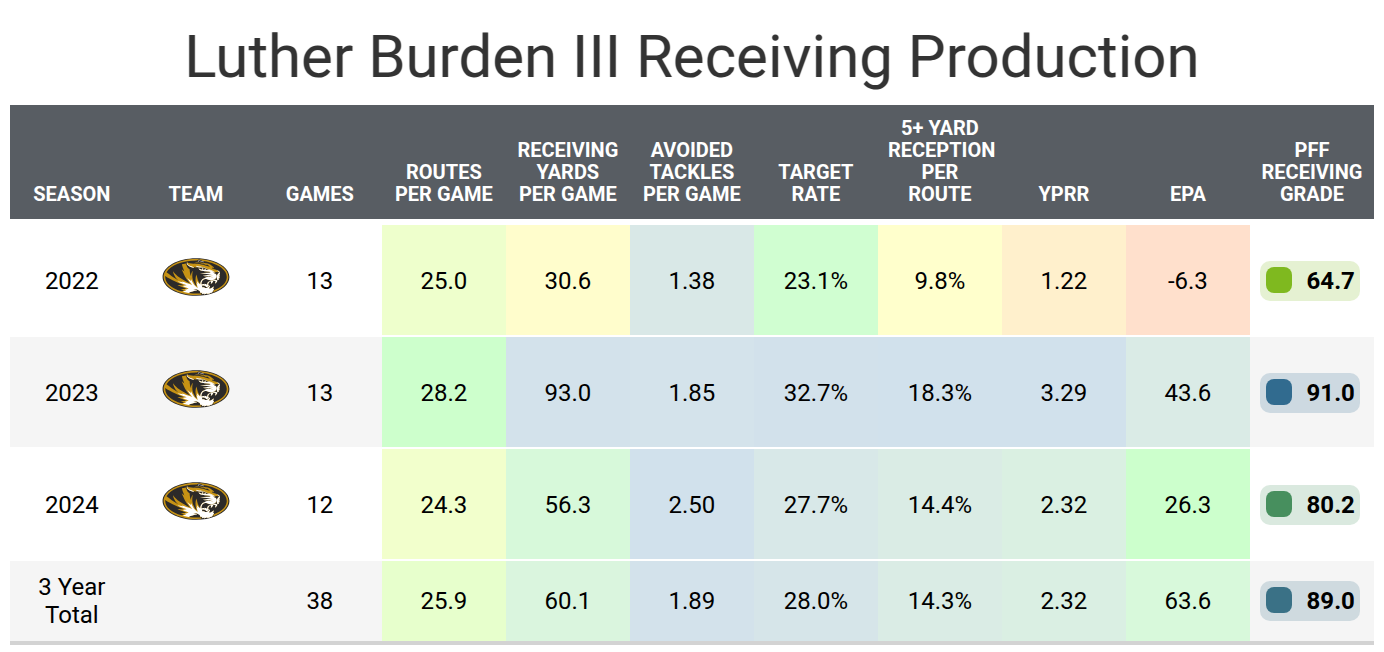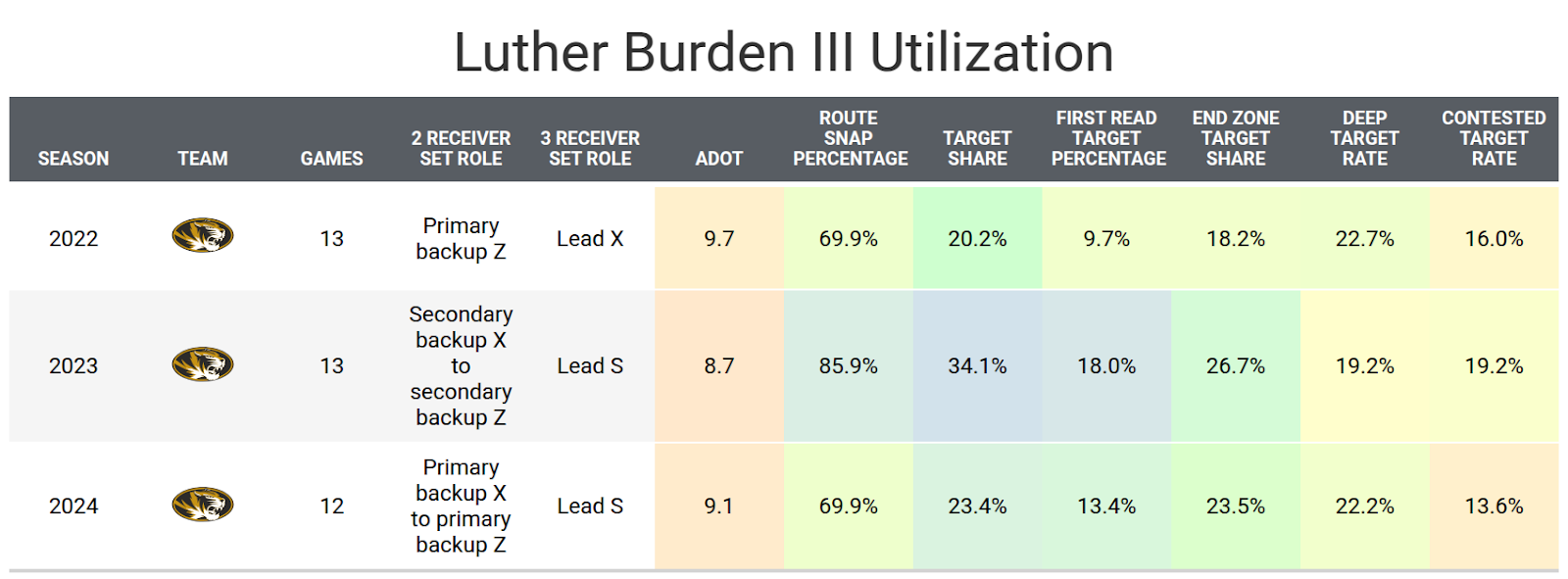- Luther Burden III is the most versatile wide receiver in the class: While other receivers might be stuck in a particular role in an offense, Burden can line up anywhere and maintain productivity.
- Burden’s stock is declining: Burden was once considered a lock for the early-to-middle parts of the first round, but he’s fallen down big boards and mock drafts. At times, he’s fallen out of the first round.
- 2025 NFL Draft season is here: Try PFF's best-in-class Mock Draft Simulator and learn about 2025's top prospects while trading and drafting for your favorite NFL team.
Estimated Reading Time: 5 minutes

PFF’s fantasy football player profile series delivers the most in-depth fantasy football analysis available for the 2025 season.
Using PFF’s exclusive data, we evaluate player performance, competition for touches and how teammates and coaching staffs will impact each player's fantasy football outlook.
Last updated: 7:15 a.m. Thursday, April 10
Click here for more draft tools:
NFL Draft Big Board | Mock Draft Simulator | NCAA Premium Stats
2025 PFF Draft Guide | Mock Draft Hub | Prospect Data Profiles
Draft Position Rankings
Player Performance
Burden has spent the last three seasons as one of Missouri‘s top two wide receivers, and the previous two played out of the slot. In 2023, he earned the third-highest receiving grade among Power-Five receivers, behind Malik Nabers and Malik Washington but ahead of Marvin Harrison Jr. and Rome Odunze. This included a top-five yards-per-route run figure, just ahead of Ladd McConkey.
Burden’s 2024 numbers weren’t nearly as strong. Reasons have ranged from injuries to general declines in the Missouri offense. The Tigers' offense was among the most run-heavy in the SEC, utilizing the second most running plays in the regular season compared to a below-average number of passing plays. That limited Burden’s routes relative to some other receivers. On a per-play basis, he remained relatively strong. His separation rate over the last two years was the best among the top five receivers in the class. Our draft guide focused on how well-rounded of a wide receiver he was, his capability to play every position and that his biggest weakness revolved around his blocking ability.


Projected Role
Burden played primarily in the slot but could play at any receiver spot. Typically, slot receivers will play better against zone than man coverage, but Burden was one of the best in the FBS against man coverage. His deep and contested target rates were also higher than other slot receivers.
Burden will likely play either in the slot or at the Z receiver spot in three-receiver sets, but the big question is if he will play in two-receiver sets. He rarely played in 12 personnel at Missouri, but the Tigers ran 11 or 10 personnel on 83% of snaps last season. Since 12 personnel were typically a running situation, they left their better run-blockers on the field.
Some NFL teams put their best two wide receivers on the field in two-receiver sets. Some teams, like the Buffalo Bills, Indianapolis Colts and Green Bay Packers, have slot receivers who only play with 11 personnel, even if their slot receiver is a better offensive weapon than the outside receivers. Even if a team views Burden as a Z receiver, a few teams – like the Baltimore Ravens, Minnesota Vikings and Pittsburgh Steelers – have a receiver who typically played on early downs. Burden’s struggles as a blocker could hurt his playing time. This would mostly hurt him in running situations, but this would also cost him some pass plays each week, and therefore, his fantasy production would also hurt.

Most Mocked Teams
Arizona Cardinals
There is no consensus on where Burden will be picked, as his draft stock has declined since mid-January. The Cardinals are one of the earliest potential landing spots at pick No. 16. As last season progressed, Arizona started moving away from its slot receiver, Greg Dortch. Burden could also play ahead of Michael Wilson in two-receiver sets.
Houston Texans
The Texans pick 25th and lack depth at wide receiver after not re-signing Stefon Diggs and losing Tank Dell for most, if not all, of last season due to injury. They traded for Christian Kirk. Burden and Kirk could rotate between the Z and slot receiver spots. The only concern is that Burden might not earn snaps in two-receiver sets with Kirk and Nico Collins on the roster.
Kansas City Chiefs
There is a chance that Burden falls to pick No. 31 or even later. The Chiefs could be set with their top three receivers – Rashee Rice, Xavier Worthy and Hollywood Brown – but Burden could give them even more talent and insurance if one of the receivers misses time. This landing spot would make Burden a high-risk, high-reward option as a rookie.
Bottom Line
Burden is a relatively safe rookie receiver with a lot of talent. From a fantasy perspective, there is some concern about his role, but that is true for nearly every wide receiver in this draft class.
Footnotes
- Statistics in tables and charts were generally chosen based on their ability to predict future fantasy performance on a per-game or per-opportunity basis or for their ability to describe the player relative to others at the same position.
- “Opportunities” are defined as passing dropbacks, rushing attempts and receiving routes run.
- Numbers are either by season or based on the past three years. For rookies, only college numbers are included. Only NFL numbers are included for non-rookies, even if they played in college during the previous three years.
- Because college competition is easier than NFL competition, most rookies will likely see a decline from their historic numbers.
- Only FBS data is considered for college players and comparisons.
- Kneel-downs are removed from rushing data to provide cleaner quarterback rushing rate statistics.
- The colors for all tables in this article range from blue (good or high) to red (bad or low).
- All percentiles or colors compare the given player to other players with a high sample of opportunities. Generally, the cut-off is one-third of the possible opportunities in the sample. If the player in question doesn’t have enough opportunities, they are still compared, even though they could look good or bad based on the small sample size, which might not be as predictive.
- Information on utilization classifications and their importance can be found here for running backs, wide receivers and tight ends.



 © 2025 PFF - all rights reserved.
© 2025 PFF - all rights reserved.